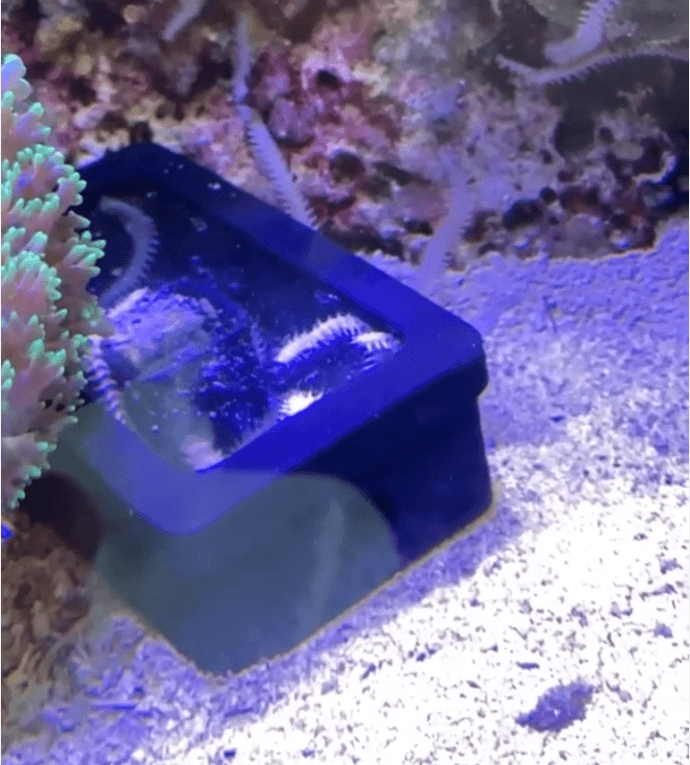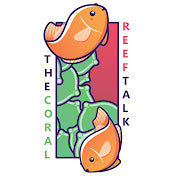Bristle Worm - The PrintedReef.com Guide To All You Need To Know About Bristle Worms
Exactly what is a bristle worm and, if you discover that you have one, what should you do about it?
First, what are bristle worms?
Bristle worms are segmented worms whose bodies feature short tufts of often white and red bristles which extend out from each of their segments and who live in water. They're normally between one and six inches in length although the biggest of them can grow to a massive 24 inches.
They nearly always live in either your tank substrate or under the live rock in your tank. They're nocturnal meaning that they only come out at night. They're very good at hiding - in fact, the only way you'll often find them is by displacing the substrate or by moving the live rock in your tank. If that doesn't work, you'll need to use a flashlight to spot them when it's dark.
So, are bristle worms good or bad news for your tank?
In the first part of our guide to dealing with bristle worms for the owners of marine aquariums, we share with you:
- What type of bristle worm might be in your tank
- Spotting beneficial bristle worms - worms you might want to keep
- Spotting bad bristle worms - worms you'll definitely want to get rid of
- What do bristle worms eat?
- How bristle worms reproduce
In part two, we examine the steps you need to take to get rid of the bristle worms living in your tank including:
- What tools can you use to remove bristle worms from your tank?
- What eats bristle worms?
- Setting a bristle worm trap
- Getting bristle worms out your fish tank yourself
- How to stop a future bristle worm infestation
And while you're here, check out Printed Reef's exclusive bristle worm trap. Want our advice on a bristle worm problem you're having? Email us at info@printedreef.com.
What type of bristle worm is in your tank?
All bristle worms belong to the polychaete worm family (specifically to the phylum of annelid worms). To date, over 10,000 species of polychaete worms have been recorded.
Bristle worms may look creepy and ugly but the truth is that most bristle worms don't actually pose any threat at all to the other animals or the coral in your reef tank.
One interesting fact about these segmented worms is that, in the way that some land worms can grow back parts of their bodies which have been torn away or damaged, so can most species of bristle worms.
The bristle needles which extrude from the bodies of these worms are how they defend themselves against their natural predators in the wild.
Spotting good bristle worms
Not all bristle worms are bad - that's a fact.
If you spot a worm with a thin body, tiny bristles, and its body is colored somewhere from gray to pink, it won't damage your coral and it's almost certainly not a threat to the other animals in your tank.
Because bristle worms are nocturnal and they like to hide, getting close enough for long enough to find out whether you have a good or a bad one in your tank can be quite difficult.
If your fish tank has a light, you should switch it off and sit ready with a flashlight waiting for it to emerge from the sand or from behind a rock. If you see nothing for a little while, you may want to choose to tempt it out by rustling the sand with a net.
Spotting bad bristle worms (fire worms)
Fire worms are very bad bristle worms. Fire worms are the members of the bristle worm population that you definitely don't want to have in your tank.
Unlike good bristle worms, fireworms are ferocious predators and they'll attack and devour the other life in your tank with both their bristles and their jaws.
How do you spot a fire worm?
Their bristle tips are white and far more visible than those on more sedentary worms. They also have much thicker bodies. You'll notice a reddish color tinge around their hair like bristles (that's because they're part of the worm's circulatory system).
What do bristle worms eat?
Beneficial bristle worms are bottom feeders - just like catfish - and they dig around in the sand and the mud in a saltwater aquarium to find their food.
The most common bristle worm is a detritivore - that's the name given to marine creatures who feed on dead fish, leftover food, and the excrement of other fish.
These species of bristle worms actually help you keep your tank clean by devouring any rotting carcass they find.
Fireworms are completely different. They'll attack the other animals living in your reef tank as well as your live rock - they are the very definition of a predator.
They're unfortunately very fond of corals.
They start off by biting off the exterior of your coral and then licking away inside to get access to more of it.
They also enjoy devouring any small invertebrate creature they come across including any mollusks or crustaceans in your tank - they're even known to target small fish.
Perhaps the biggest and scariest of these fire worms are the infamous bobbit worms.
Bobbit worms, perhaps the least wanted critter you could wish for (the other being the bearded fireworm), hide patiently and unnoticed in sand only appearing fleetingly to snatch unsuspecting fish and other animals in your tank. They then devour them away from attention in their well-concealed burrows.
How bristle worms reproduce
Bristle worms require a pair to mate - the female releases her eggs and the male his sperm in the same area.
For all types of bristle worm, their rate of reproduction is determined by how much food they eat. Fireworms are voracious feeders and this means that, if there's a lot of food around, then they'll have lots of babies much faster than their good bristle worm cousins.
How quickly good bristle worms breed at is influenced by the amount of food you feed your fish as well as how clean you keep your reef tank.
Removing bristle worms from reef aquariums
What kills bristle worms?
Bristle worms and fire worms are welcome meals for the following natural predators:
- Arrow Crab (Stenorhynchus setrcornis)
- Bird Wrasse (Gomphosus varius)
- Butterflyfish (certain species)
- Coral Banded Shrimp (Stenopus hispidus) (including the red and white coral branded shrimp)
- Dottyback
- Maori Wrasse (Cheilinus oxycephalus)
- Puffer fish (certain species)
- Sunset Wrasse (Thalassoma lutescens)
- Wrasse of the Halichoeres family (including the Maori Wrasse if you have a very large tank)
Please bear in mind that, as natural predators, they'll look for other food to consume once they've eaten the bristle worms in your tank.
This means that you'll have to constantly supply them with their other favoured prey to stop them eating the crustaceans, inverts, and other animals you actually want to keep alive. Be warned though that even the introduction of new prey doesn't guarantee that the creatures you want to keep safe won't become a target though.
Setting bristle worm traps
Using a specially designed bristle worm trap is the best way for getting rid of unwanted bristle fish from reef tanks - click here to see the trap we've designed.
You may also want to use a giant suction syringe to suck bristle worms up as well as any other dead fish or dead animals on or under the sand of your aquarium.
Other methods to remove worms from your tank include using:
- long tweezers for the easiest bristle worms to see and reach,
- mechanical tongs for people with bigger tanks where it's harder to get to the bottom, and
- a plastic bottle with tiny holes on the side inside of which you place bait to attract the bristle worm. Fill the holes you've created with plastic tubing that the worms will have to crawl through to get to the bait and, most of the time, they'll get trapped.
DIY bristle worm removal
If you don't like the idea of trapping them, especially if they're lodged tight in the holes and cracks of your live rock, take the affected live rock out of your tank and place it straight away in a bucket of dechlorinated fresh water.
When you do this, the worms normally exit the live rock quickly and gather in the bottom of your bucket.
Bristle worm FAQs
Can you touch bristle worms?
You should avoid touching bristle worms directly - wear gloves instead (heavier gloves if you want to handle the worms).
The bristles on most worms snap off (like cactus bristles) and they can easily penetrate the skin.
If you're scratched by one, you may feel some localized irritation. When trying to get rid of a bristle worm from your fish tank (especially a fire worm), it's a good idea to wear protective clothing because some species of bristle worms can actually be quite toxic.
Can you have too many bristle worms?
If they're the good type of bristle worm, think of them as your very own clean-up crew. If you have lots of them, this means that there's enough food to support them.
This therefore may indicate other problems in your reef tank like the presence of too many dead fish and other dead organisms, too much fish waste, and too much uneaten food.
How do you get bristle worms?
The most common way for bristle worms to find their way into your reef tank is when you purchase a new live rock for it.
If you're absolutely determined to prevent these little worms from getting into your main tank when you buy new coral reefs, you might want to consider putting the reefs in a control tank first.
By using a control tank, you'll keep all the good bacteria and other organisms present in the coral that you want to keep and, in a short time, the bristle worm will eventually reveal itself as it starts searching for food.
Other resources you might want to check out
Want to know more? We've collected together the following list of links if you want to know even more about bristle worms:
- Bristle Worms vs Fireworms? - a great article from the Atlantic Reef Conservation website with video of four different worms (including the Bobbit worm)
- Should You Keep Bristle Worms In Your Aquarium? - from Robert at Fishkeeping World
- Critter Identification: Bristle Worms - a really informative piece from First Time Marine Keeper
- Bristle Worm Removal from Saltwater Aquariums - a mammoth article from the Reef Builders community
- Bristle Worms: The Creepy Creature Hiding In Your Aquarium - from the team at FishLab
- Should you have bristle worms in your aquarium? A complete fact sheet, breeding, behavior, and care guide - from Vivofish
Get in touch with PrintedReef.com
While you're here, why not check out our bristle worm trap? Please click here.


